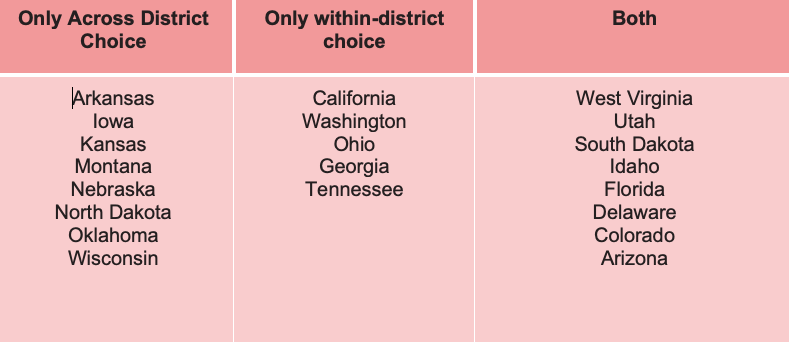In 2023, Republican dominated states vigorously championed universal school vouchers and education savings accounts. In fact, EdChoice called 2023 the year of universal choice, as 19 states either created or expanded private school choice. However, what garnered less attention was a smaller parallel surge in public school choice.
Last year, according to an analysis by Jude Schwalbach, five states passed strong open-enrollment laws, allowing families to attend public schools outside of the school they were assigned to. Currently, 21 states allow within-district choice, across-district choice, or both, substantially increasing the number of states allowing open-enrollment from 2022. Eight states now allow school within-district and across-district choice, eight others allow only across-district choice, and five others allow within-district choice.[i]

Notably, many of the state legislatures that expanded open-enrollment in 2023 did so on a bipartisan basis and without much controversy. For example, both Montana’s and West Virginia’s open enrollment bills passed unanimously and Idaho’s bill passed 98-5.
Unfortunately, none of these were in blue states and none were led by Democratic governors.
In fact, not one of the 18 states where Democrats control both the legislature and the Governor’s office had any substantial measure enacted to expand public school choice. Only two traditional democratic states have strong provisions for students to transfer to a school district beyond their assigned school district[ii].
This is not only a moral failure, but also a political one.
The vast majority of students go to public schools based on where they live. This system is not only antiquated but also perpetuates injustice, actively reinforcing pre-existing inequities instead of embodying the equitable playing field it purports to represent. This is due to the fact that school assignments are primarily determined by where you live, and where you live is decided by how much wealth you have. Wealthy neighborhoods and impoverished neighborhoods didn’t emerge from chance, they resulted from intentional design.
For decades, the federal government rated neighborhoods based on how stable they were. Neighborhoods where black and other people of color lived were marked in red, barring them from being insured or receiving government subsidies.
This insidious policy denied generations of families of color the opportunity to own a home, and even if they did, housing prices appreciated much less for black neighborhoods than non-black neighborhoods.
These “redlined” neighborhoods are the antecedent of today’s school districts, as numerous scholars like Tim DeRoche have pointed out. While redlining was made illegal in 1968, forms of inequity perpetuate housing policy today.
Currently, neighborhoods frequently enforce zoning restrictions that outright prohibit the construction of multi-family homes or apartments, effectively barricading the prospect for low-income families to reside in wealthier communities.
Democratic leaders have spoken eloquently about the long, pernicious history and current reality of housing segregation in our county. The Democratic Party Platform in 2020 states:
Decades of red-lining, rising income inequality, and predatory lending practices targeting low-income families and people of color have made homeownership all but impossible for millions of working families.
If the Democratic Party acknowledges the deep and intractable issues within our housing policy, wouldn’t it be prudent for the party to proactively work towards disentangling the intricate connection between schooling and housing?
Embracing open-enrollment is not only a moral imperative, it’s also a political winner.
Public school choice enjoys widespread popularity among crucial demographics in swing states, particularly among Black, Hispanic, and Independent voters. In an upcoming election that shows indications of the traditional Democratic base lacking enthusiasm (including a poll released this week that showed Biden losing Hispanic voters to likely Republican nominee Donald Trump, something unthinkable just a few years ago), embracing public school choice could serve as a pivotal issue to rally support for traditional Democrats.
Morally and politically, the evidence is clear: Democrats should support public school choice through open-enrollment.
2023 was the year of private school choice across many Republican states. Democrats need to make 2024 the year of public school choice by embracing open-enrollment. Because let’s face it: a public education system where you need to obtain a large mortgage to get quality education is not a real public education system at all.
[i] Reason Foundation has been a leader in tracking open enrollment policies. For further analysis, read their full report here.
[ii] Majority of states have policies in the books for students to transfer to another district, but it is either voluntary for districts to participate or both districts have to agree on the transfer, or the policy is unclear (for example, Washington state).